Abstract
We investigated the distribution patterns and evaluated the average contents of trace elements in the k7 seam of the Karaganda coal basin in Central Kazakhstan. This paper presents the results of studying the geochemistry of 34 elements in 85 samples of the k7 seam. The study employed a suite of advanced high-resolution analytical methods, including atomic emission spectrometry with inductively coupled plasma (ICP–OES) and mass spectrometry with inductively coupled plasma (ICP–MS), along with their processing and interpretation. It was determined that the concentrations of trace elements in the k7 seam are primarily associated with lithophile elements, revealing high concentrations of Li, V, Sc, Zr, Hf, and Ba. Additionally, increased concentrations of Nb, Ta, Se, Te, Ag, and Th were observed compared to the coal Clarke. Specific Nb(Ta)–Zr(Hf)–Li mineralization accompanied by a group of associated metals (Ba, V, Sc, etc.) was identified. The study revealed lateral and vertical heterogeneity of the rare elements’ distributions in coals, attributed to the formation dynamics of the coal basin. A correlation between Li and Al2O3 with a less positive relationship with K2O suggests the affinity of certain elements (Li, Ta, Nb, and Ba) to kaolinite. Clay layers showed increased radioactivity, with Th—13.2 ppm and U—2.6 ppm, indicating the possible presence of volcanogenic pyroclastic rocks characterized by radioactivity. Taken together, these data reveal the features of the rock composition of the source area, which is considered a mineralization source. According to geochemical data, it was found that the source area mainly consists of igneous felsic rocks, indicating that the formation occurred under conditions of a volcanic arc. This study’s novelty lies in estimating the average trace elements in the k7 seam, with elevated concentrations of certain elements that suggest promising prospects for industrial extraction from coals and coal wastes. These findings offer insights into considering coal as a potential source of raw material for rare metal production, guiding the industrial processing of key elements within coal. The potential extraction of metals from coal deposits, including from dumps, holds significance for industrial and commercial technologies, as processing critical coal elements can reduce disposal costs and mitigate their environmental impact.
Keywords:
coal basin; clay layers; trace elements; coal seams; high concentration; coal Clarke; geochemistry 1. Introduction
In recent years, there has been increasing interest in studying the elemental geochemistry of coal, aiming to maximize the exploitation of valuable elements while mitigating the environmental and human health risks posed by toxic trace elements [1,2]. Updated analytical methods have expanded the possibilities for investigating the accumulation mechanisms of trace elements in coals. Despite this, the geochemistry of coals, including that of Kazakhstan, remains incompletely understood, with research on rare trace elements in coals being a relatively recent development [3]. As traditional sources of trace element accumulation become depleted, scientists worldwide are exploring non-traditional sources, including coal deposits, where valuable rare trace elements can be found and extracted. Interest in the presence of valuable trace elements in coals containing industrial concentrations continues to grow annually [4,5,6,7,8,9,10,11].
In deposits of brown and hard coal of nearly any age and genetic type, more comprehensive sets of elements are typically found [12,13]. The principal distinctions arise from the metallogenic’s tectonic positioning and the surrounding rocks’ geochemical characteristics. These factors influence the conditions for coal basin formation, as well as the composition of the rocks within the basin, which include igneous rocks, and are affected by hydrothermal processes occurring in the basement of the basin, as well as the paleoclimatic and paleogeographic conditions of the basin formation [14]. Kazakhstan, known for its substantial reserves of hard and brown coal, exemplifies this trend. The selection of the study object is dictated by research objectives such as assessing the average content of trace elements in coals; investigating patterns of their accumulation in coal-bearing deposits; evaluating the impact of various geological environmental factors on their concentrations in coals and clay layers; studying the conditions governing element concentration and fractionation in geological processes; and determining their forms of occurrence in coals [15,16].
Kazakhstan ranks among the top ten countries globally in terms of coal reserves, trailing only China, the USA, Russia, Australia, India, South Africa, and Ukraine; it holds approximatively 4% of the world’s total reserves. The majority of these coal deposits are concentrated in Central Kazakhstan, with the Karaganda coal basin emerging as one of the largest and most promising basins in Kazakhstan [17]. Understanding the concentrations of trace elements in coals from the Karaganda coal basin promises comprehensive extraction of valuable components from organic fuel [3]. Utilizing critical elements extracted from coal in the Karaganda coal basin offers numerous benefits, rendering it an economically and environmentally attractive option, particularly for major coal-consuming nations like China, the United States, Russia, India, and others [17].
It has been established that coal is significantly enriched with trace elements, and in recent years, promising options for extracting elements from them have been proposed [18,19]. However, despite the high content of these elements in coals, they pose an environmental problem. Potentially hazardous elements for the environment can be directly released during the use of coal, mining or transportation of coal, disposal of coal mining waste, and by-products of coal combustion [20,21]. Therefore, it is vital to determine the content and distribution of chemical elements in coal. Obtaining rare elements from coal is an important embodiment of clean/eco-friendly and efficient use of coal, which is of great strategic importance for the development of a “green” economy [22].
This article presents data on the distribution of impurity elements in coal deposits, including some rare metals (Ge, Ga, Se, Li, and REE + Y), which play a key role in energy-efficient technologies. The main purpose of this study is to investigate the geochemical characteristics of coal deposits, as there are many deposits worldwide that contain high concentrations of Ge, Ga, Se, Li, and REE+ Y. Rare metals are found in both coal and host rocks, as well as foundation rocks. The genesis of metal accumulations and the method of their occurrence may vary. Extraction of metals from coal deposits is a potentially new way to develop clean energy.
It is shown that enrichment of these metals can occur in coal seams and in host rocks. The genesis of high concentrations of rare metals and the patterns of their occurrence in coal basins are considered. In addition, the prospects of using these metals as a by-product of coal deposits are being evaluated. The extraction of these metal resources during the development and use of coal will not only increase the usefulness of the coal deposits themselves, but will also contribute to the further movement of mankind along the “green path”.
Deposit Characterization
The Karaganda coal basin, situated in the Karaganda region of Central Kazakhstan (Figure 1), lies within the western section of the Central Asian orogenic belt—and is characterized as a synclinorium in tectonic terms [15,23,24]. This synclinal structure represents a complex yet relatively cohesive large-scale structure oriented latitudinally, comprising Devonian–Silurian volcanic-sedimentary rocks and a coal-bearing series dating back to the Carboniferous age.
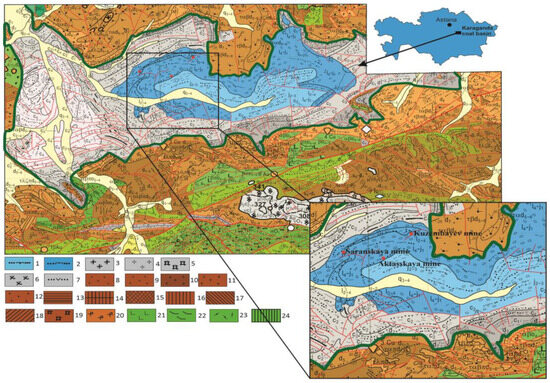
Figure 1.
The geological structure of the Karaganda coal basin (highlighted in bold) and the studied area. A fragment of the map of the M-43-V sheet, scale 1:500,000 (Serykh, 2007), [24]. 1—polymictic grauwacki, medium (j2-3); 2—polymictic grauwacki, sour (l4–j1); 3—monzogranite (K granite) (μγ4c22-4); 4—leukogranite (lγ1c6–p1); 5—K–Na granosyenite (γξ2c7–p2); 6—monzogranodiorite (K granodiorite) (μγδ3c22-4); 7—petroclastic grauwacki, medium sodium (c); 8—Na trachyandesite (ταd5-6, ταc2-4); 9—Na trachydacite (τϚd5-6); 10—K trachyriodacite (τλϚd5-6); 11—K trachyandesibasalt (ταβd5-6); 12—trachybasalt (τβd5-6); 13—Na and K–Na trachyandesibasalt porphyrites (ταβπd5-6); 14—Na and K–Na trachyandesite porphyrites (ταπd5-6); 15—trachyriolite porphyry (τλπd5-6) and ayuriolite porphyry (υλπd5-6); 16—trachybasalt porphyrite (τβπd5-6); 17—Na and K–Na trachyriodacite porphyries (τλζπd5-6); 18—Na, K–Na, and K trachydacite porphyries (τζπd5-6); 19—K–Na quartz monzonite (qμd5-6, qμc7-p2); 20—K–Na syenogranites (εγ3d5-6); 21—basalt (βo4-5); 22—andesibasalt (αβo4-6); 23—ayulit (νo1); 24—basalt and tholeiitic porphyrites (βπo4-6).
The coal-bearing formations within the Karaganda basin span from the Carboniferous to Jurassic periods. The basin’s foundation comprises marine Upper Devonian sediments, along with metamorphosed effusive and sedimentary rocks from the Middle and Lower Devonian and Silurian periods, which form its perimeter. Carboniferous deposits are prevalent in the central region, while Jurassic deposits dominate the eastern sector. These coal-bearing strata, with a thickness ranging from 4500 to 5000 m, begin with Upper Tournaisian deposits. The lower segment of this sequence contains marine fauna and flora, and within these layers, formations such as Akkuduk, Ashlyarik, Karaganda, Nadkaraganda, Dolinskaya, Tentek (Naddolinskaya), and Shakhan formations are discernible based on coal content and lithological composition [15,16,23].
The Karaganda basin is divided into four districts: Tentek and Churubay-Nurinsky in the west, Karaganda in the center, and Verkhne-Sokursky in the east, each with its industrial and geological significance.
The Karaganda industrial, situated in the heart of the basin, is extensively explored, hosting the majority of active mines. Conversely, the Verkhne-Sokursky district, characterized by low-quality and significant depth, holds less promise for hard coal mining but is undergoing exploration for brown coal. The k7 seam under study part of the Karaganda formation located within the Karaganda industrial district, was sampled from the Saranskaya, Aktasskaya, and Kuzembayev mines [23].
Productive hard (coke coal) coal deposits are represented by the Ashlyarik (C1), Karaganda (C1), Dolinskaya (C2), and Tentek (C2-3) series, which contain up to 30 coal seams with a total working capacity of 40 m. The studied samples were taken from the faces of operating mines, where the k7 seam of the Karaganda suite of the Carboniferous system is being worked out, with a thickness ranging from 1.5 m to 10 m. The Karaganda suite is the second productive formation of the basin and is widespread on the wing of the Karaganda syncline. The coal seam is mainly represented by matte and semi-matte differences of coals with numerous interlayers of clay rocks, with the thickness of the studied clay interlayers ranging from 3 to 20 cm [15,23].
2. Methods
For a detailed geochemical study of the k7 hard coal seam, clay layers (referred to as CLs), the roof and bottom of the seam, and the contact zones between the clay layer and the roof and bottom were tested and studied. Selected samples of the k7 seam currently being worked out were obtained in three operating mines, namely Saranskaya, Aktasskaya, and Kuzembaev. The testing was carried out using the furrow method (vertical sampling) from layers of coal and host rocks with a thickness of 0.05–0.20 m, covering 35 sections. The distance between the sections varies from approximatively 500 m to 800 m, with the distance between the first and last sections being approximatively 2.9 km. A total of 175 samples of coal, clay interlayers, and coal–clay interlayer contact zones were taken, with 5 samples collected in each section to trace the lateral and vertical changes in the mineralogical and geochemical features of the k7 seam. Sample preparation, involving reductions in initial samples weighing 1.5–2 kg and their abrasion to 250 g, was conducted in the laboratory of Azimuth Geology LLP, Karaganda. Laboratory and analytical studies were carried out in the accredited leading laboratory specializing in coal research, at the analytical center of the Far Eastern Geological Institute of the Far Eastern Branch of the Russian Academy of Sciences (RAS FEB FEGI). The analysis of trace elements was determined using inductively coupled plasma atomic emission spectrometry and inductively coupled plasma mass spectrometry on an Agilent 7500 spectrometer (Agilent Technologies, Santa Clara, CA, USA) (ICP–OES and ICP–MS). The distribution of minerals, shapes, and morphological features of coal and clay layers were studied using analytical scanning electron microscopy in combination with energy dispersive X-ray spectroscopy (SEM–EDS) at the RAS FEB RAS. A detailed description of the analytical methods used in the study is provided in [24].
3. Results and Discussion
In the laboratory and analytical studies, we examined 85 coal samples: 25 from the Saranskaya mine, 40 from the Kuzembayev mine, and 20 from the Aktasskaya mine. Trace elements were established, and their average contents in the k7 seam coals and clay layer are presented in Table 1.

Table 1.
Average contents of trace elements in the k7 seam, in coal and in clay layers of Karaganda coal basin.
According to the data in Table 1, the coals exhibit increased contents of Li, Sc, V, Cu, Se, Zr, Hf, Ag, and Te compared to the coal Clarke, while the clay layers (CLs) show high concentrations of Li, Sc, V, Ga, Se, Sr, Nb, Ta, Sn, Ba, Hf, and Th.
The distribution graphs in Figure 2 reveal that the elevated content of trace elements is predominantly confined to the clay layers (CLs), as clearly visible for Li—(137.6 ppm), Sc—(9.6 ppm), Ga—(31.1 ppm), Sr—(198.6 ppm), and V—(239.0 ppm). Additionally, increased radioactivity of Th—(13.2 ppm) and U—(2.6 ppm) is evident in the CLs. In contrast, the coals exhibit a high content of Sr—(63.2 ppm), Zr—(46.64 ppm), and V—(36.98 ppm), with clearly visible, relatively weak radioactivity observed for Th—(1.21 ppm) and U—(0.43 ppm).
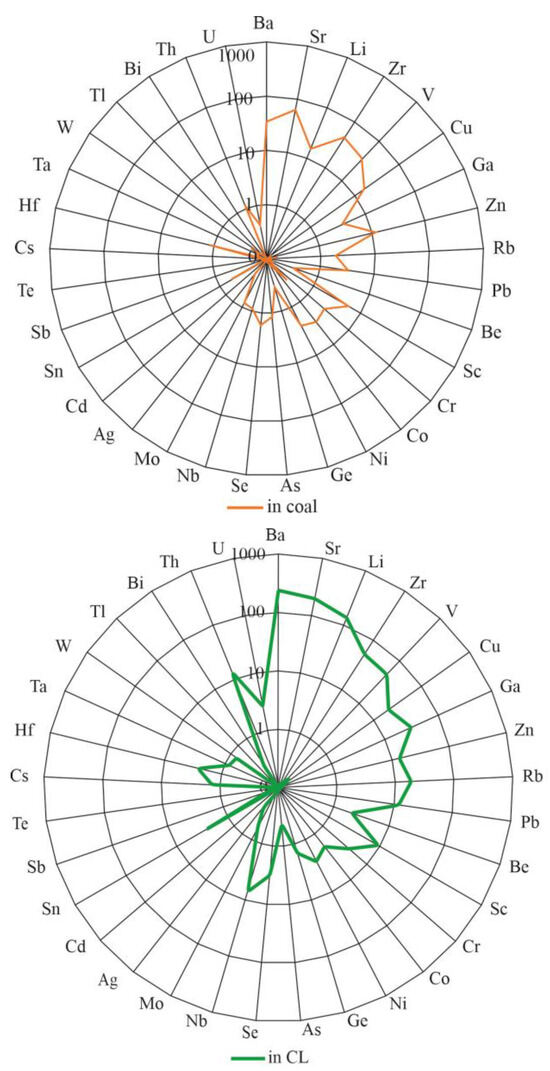
Figure 2.
A graph of the distribution of trace elements (Table 1) in the coal and in CLs of the k7 seam.
The vertical total distribution of trace elements in the k7 seam clearly shows an increased concentration of trace elements in the contact zones between the clay layer (CL) and the roof and bottom of the k7 coal seam (UC and LC) (Figure 3). However, it was also established that, in the clay layers, the total content of trace elements has the lowest value, as clearly demonstrated in Figure 3 (see just above).
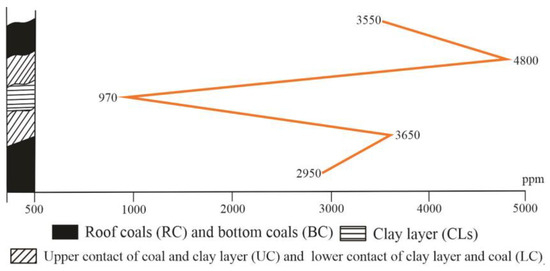
Figure 3.
Vertical total distribution of trace elements (Table 1) in coals (RC and BC), in the clay layers (CLs), and at the zones of contact of CL–coal with the roof and bottom (UC and LC) of the k7 seam of the Karaganda coal basin.
A detailed geochemical analysis of the k7 seam enables the identification and evaluation of the main factors contributing to the accumulation of trace elements in coals. The distribution of trace elements in the coals of the k7 seam revealed three series with increased element contents classified as lithophile, siderophile, and chalcophile series (Table 2).

Table 2.
Average contents of trace elements in the k7 seam, ppm.
The main rock-forming elements (Al, Ti, Fe, Ca, Mg, K, Na, and P, in oxide form) are presented in Table 3. Analysis of their distribution indicates that, among the lithophile elements listed in Table 2, Li, V, Zr, Hf, Ba, Nb, Ta, Th, and U are particularly noteworthy; their average contents are either close to or significantly exceeding the Clarke value in coal. The analysis of the distribution and accumulation of these elements holds significant interest for the potential development of new types of rare metal and coal deposits [3].

Table 3.
Average content of rock-forming elements in the k7 seam.
To delineate the lateral variability of lithophile elements, distribution graphs were constructed for these elements in coals and clay layers (CLs) of the k7 seam, revealing considerable spatial heterogeneity within the seam (Figure 4).
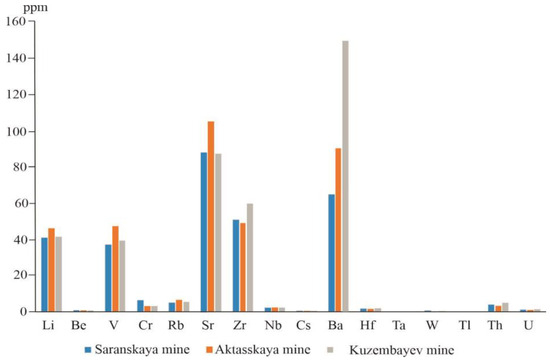
Figure 4.
Distributions of the average contents of lithophile elements (Table 2) in the k7 seam of the Karaganda coal basin.
The data in Table 2 reveal that the analyzed coals exhibit elevated levels of lithophile elements such as V, Zr, and Hf compared to the coal Clarke. Notably, all three mines show high concentrations of Li. Additionally, there is an increasing trend in the contents of Zr and Hf from the west (Saranskaya mine) to the northeast (T. Kuzembaev mine), with the lowest levels observed at the Aktasskaya mine (Zr—49 ppm and Hf—1.43 ppm). The lateral distribution of Hf mirrors that of Zr, and the same distribution has been observed by other researchers [3,26,27,28,29].
The vertical distribution of Zr and Hf exhibits significant variation. At the Saranskaya mine, elevated levels of Zr and Hf are concentrated in the contact zones, with the highest concentrations observed at the Kuzembayev mine. Conversely, at the Aktasskaya mine, maximum concentrations of Zr and Hf are found in the CLs with lower levels in the contact zones. In the contact zones, the Zr/Hf ratio is notably higher (ranging from 38 to 60) in coals compared to the CL itself (25), suggesting reduced mobility of Hf relative to Zr under these conditions. While the factors influencing Zr concentration in coal seams are not yet fully understood, terrigenous and volcanogenic solid materials rather than aqueous solutions are considered the primary suppliers of Zr, although elevated organic matter accumulation in them is also possible [25,29]. Similarly, potential factors for Hf accumulation in coals include the erosion of alkaline rocks in provenances, as well as the presence of pyroclastics and the discharge of carbon dioxide thermal water rich in Zr and Hf into peat bogs (or coal seams) [27,28].
In both the coals and CLs of the k7 seam, a strong correlation between Zr and Hf was evident (Figure 5), suggesting a commonality in their accumulation levels and sources of origin [3,30].
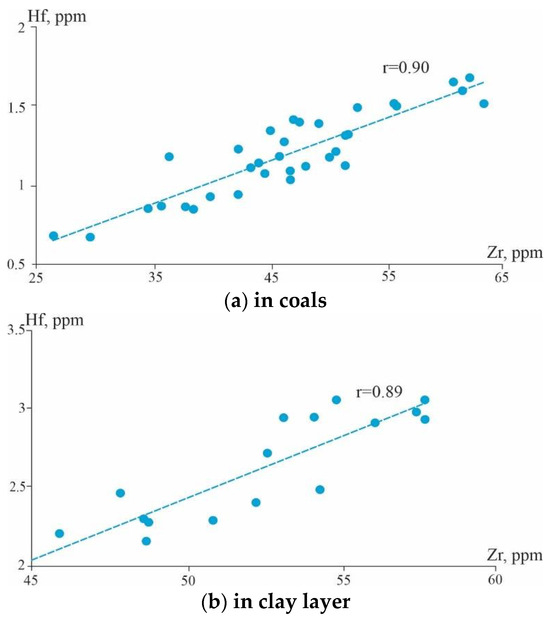
Figure 5.
Correlations graphs regarding Zr and Hf in coals and CLs in the k7 seam of the Karaganda coal basin.
A notable characteristic of the k7 seam is its exceptionally high Li content observed in all three mines, with a maximum Li concentration in coal of 38.7 ppm, significantly surpassing the Clarke value in coal of 14.0 ppm and 184.1 ppm in CLs with Clarke argillite values of 33 ppm. Furthermore, the average content of Li concentrations in the k7 seam increases from the west (Saranskaya mine), reaches a maximum of 46.2 ppm at the Aktasskaya mine, and decreases to the northeast (T. Kuzembaev mine). Interestingly, the distribution of V mirrors that of Li across the mines, with a maximum V content of 71.52 ppm recorded at the Aktasskaya mine (Figure 6a).
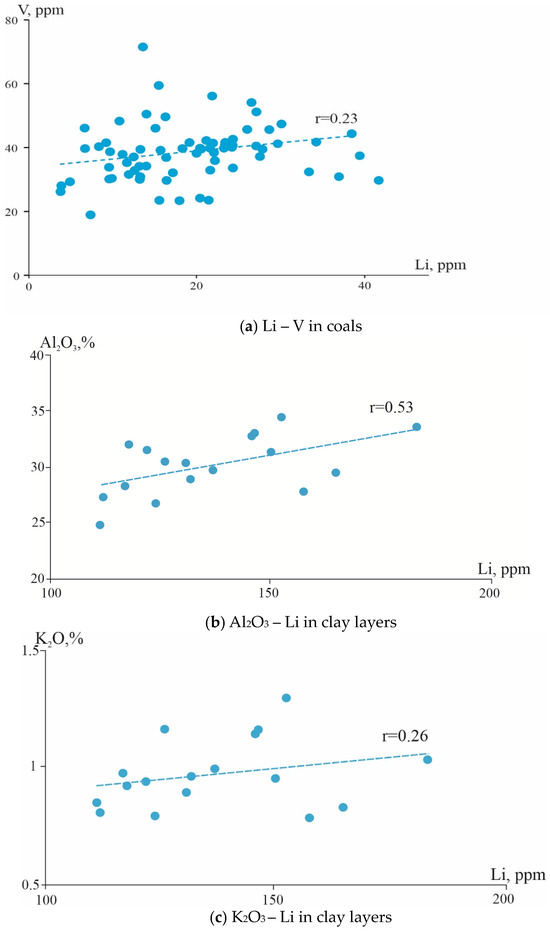
Figure 6.
Correlation of Li–Al2O3 and Li–K2O with CLs.
It was found that the elevated concentration of Li is primarily found in the CLs. According to geologists from Tomsk, approximately 40% of Li in coals is linked to organic matter [25]. The presence of Li in coals (up to 114 ppm) and CLs (631–1000 ppm) suggests the dominance of the Limin form, indicating that Li may be part of clay minerals [25]. Additionally, a positive correlation between Li and Al2O3, and a less pronounced correlation between Li and K2O (Figure 6b,c), possibly suggesting the affinity of Li to kaolinite rather than hydromicas, hints at the sorption-based accumulation of Li in the clay layer; the researchers in [31] found that the Li and Ga enrichment was due to the presence of kaolinite. It can also be noted that one of the important factors of Li accumulation is mechanical weathering [25]. The association of Li and Ga with organic matter remains a subject of debate, with some authors proposing a connection to fine clay minerals (aluminosilicates) such as kaolinite dispersed within coal (ash), while others consider this association to be partly with organic compounds [31,32,33]. The high levels of Li in CLs suggest this first interpretation. Since coal deposits could act as potential alternative sources for some trace elements, this aspect is crucial, particularly if there are plans for industrial secondary valorization of these transition elements.
The Ta and Nb contents across all three mines fall below the Clarke value in coals, with the highest concentrations observed in the northeast (at the T. Kuzembaev mine) of Ta—0.28 ppm and Nb—2.38 ppm, compared to Clarke values in coals of Ta—0.3 ppm and Nb—4.0 ppm. The Ta-to-Nb ratio varies from 12 to 28 from the bottom to the top of the formation, and from 13 to 74 in the contact zone, indicating a notably higher mobility of Nb compared to Ta during interlayer transformation, and rare metal mineralization in the contact zone and CLs. The elevated concentrations of Ta and Nb in all three mines, particularly CLs, suggest a clastogenic mechanism predominantly responsible for their introduction into coals.
The accumulation levels of Ta and Nb are higher in the contact zone between the base and the CL compared to that between the CL and the roof at all three mines. At the Aktasskaya mine, the Ta/Nb ratio in coals is higher than at the Saranskaya mine and the Kuzembayev mine. These anomalies suggest similar natures, indicating that, amidst clastogenic accumulation of elements, the predominant mechanism involves sorption concentrations of Ta and Nb from ground and surface waters [34,35,36,37].
A high concentration of Ba (160 ppm, Table 2) was observed primarily in the northeast (at the T. Kuzembaev mine), followed by those at the Saranskaya mine (Ba, 65 ppm) and the Aktasskaya mine (Ba, 90 ppm), where the Ba content is slightly lower than the Clarke value (Ba, 150 ppm). Figure 4 illustrates that the Ba content is notably higher compared to the other lithophile elements in both coals and CLs. The maximum Ba concentration, like those of Li, Ta, and Nb, was found in CLs, suggesting predominantly clastogenic accumulation of Ba in the k7 seam [25]. Furthermore, the highest Ba concentration was noted in the contact zones of the roof and bottom with the CL in the northeast (at the T. Kuzembaev mine), and with the bottom-CL contact zone exhibiting greater Ba enrichment than the roof-CL contact zone (Figure 7). This phenomenon manifests diversely due to varying accumulation natures of a positive correlation between Ba and Al2O3 as well as Ba and K2O (Figure 8), and may indicate the attraction of Ba to kaolinite and hydromicas, suggesting a sorption (Basorb) mechanism for natural Ba accumulation from ground and surface waters [25].
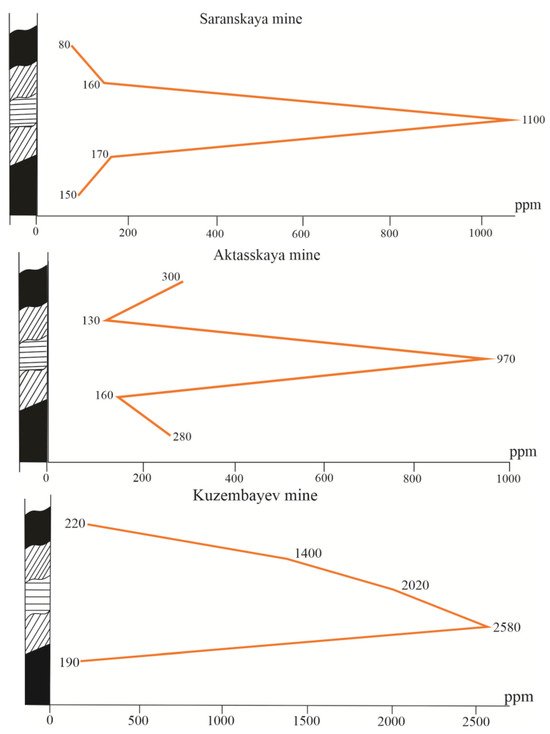
Figure 7.
Vertical Ba distributions in coals and CLs in the k7 seam of the Karaganda coal basin. The symbols are shown in Figure 3.
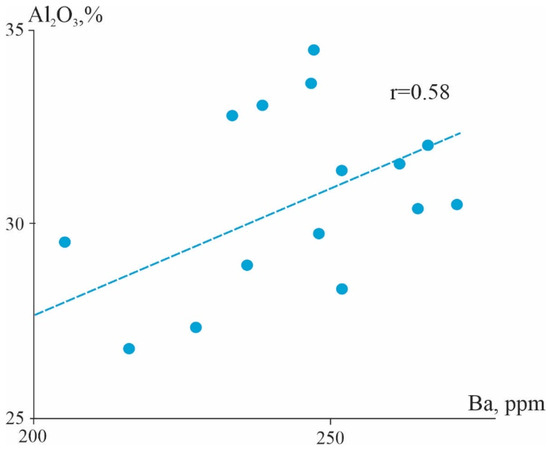
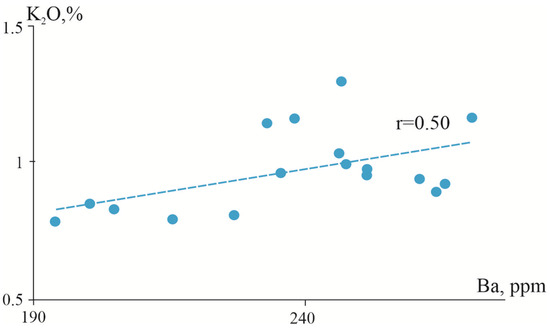
Figure 8.
Correlation of Ba–Al2O3 and Ba–K2O with CL.
The radioactive elements in the coals of the k7 seam exhibit concentrations approaching Clarke values [25]. Specifically, the Th concentration of 3.81 ppm surpasses the Clarke value (Th 3.2 ppm) in coal, peaking at 3.29 ppm in the west (at the Saranskaya mine) at 3.29 ppm, and notably increasing to 4.79 ppm to the northeast at the Kuzembayev mine, while declining at the Aktasskaya mine. Conversely, the U content in coal does not meet the Clarke value in the k7 seam, with the highest U content observed at the Kuzembayev mine (1.29 ppm) and Saranskaya mine (0.97 ppm), and the lowest at the Aktasskaya mine (0.81 ppm). The average Th content in CLs (13.2 ppm) exceeds the Clarke argillite values (7.7 ppm) by two times. Likewise, the average Th values range from 0.6 to 16 ppm in the k7 seam and correspond to the global average reported by the IAEA [38,39,40] (3.7–97 Bq/kg), which indicates that there is no significant health risk from the use of coal from the k7 seam. The distribution pattern of Th and U in the k7 seam closely mirrors that of other lithophile elements (Figure 3).
Comprehensive studies [41,42] of the forms of U and Th in coals have shown that organic matter plays an important role in their concentrations in all types of coals. During the carbonification process, changes in the structure of organic matter lead to alternations in the ratio of U and Th forms. The significance of mineral forms in their distribution increases. Rare earth phosphates and other accessory minerals are the main Th concentrator in hard coals. Uranium in coal exists in mineral form as well as in scattered form. Under specific conditions, coal can even host its own minerals (oxides and silicates) despite extremely low U content (<2 ppm).
The high correlation coefficients between Th and U in coal (0.77) and CLs (0.96) suggest joint migration and indicate reducing environmental conditions (Figure 9a). This pattern is primarily characteristic of volcanogenic pyroclastic rocks with an alkaline composition, which are known for their heightened radioactivity [3]. However, under oxidizing conditions, uranium tends to oxidize, forming a uranyl ion, and consequently migrates more actively, leading to a disruption in the correlation in coals (Figure 9b,c) [3].
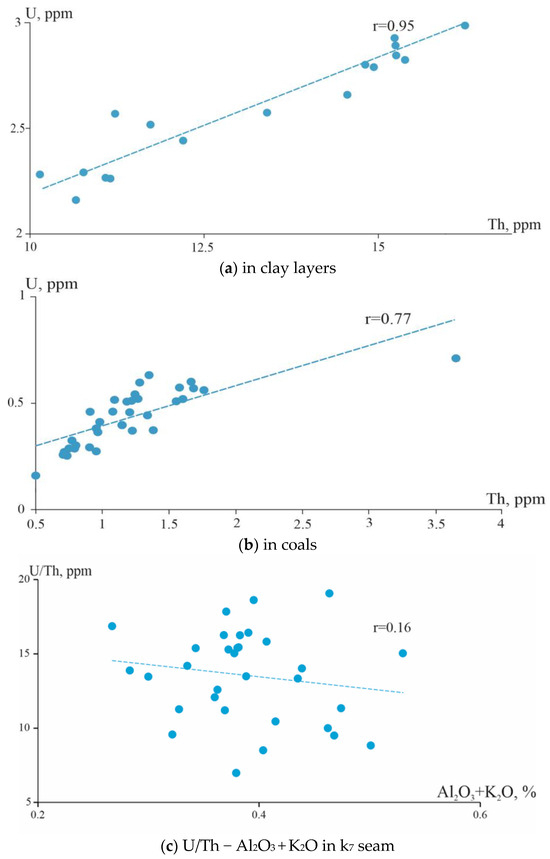
Figure 9.
Correlation graphs of U and Th in clay layers and coals of the Karaganda coal basin.
The elements of the chalcophile group, including Te, Cu, Ga, Se, and Ag, are also of industrial interest, to which their average contents slightly exceed the Clarke value for coal (Table 2).
A distribution diagram of these chalcophile elements in both coals and CLs is depicted in Figure 10. According to Table 2, there is an anomalous sulfur (S) content ranging from 2530 to 7390 ppm, with the S concentration increasing towards the west (at the Saranskaya mine). The maximum content is observed at the Aktasskaya mine, and decreases towards the northeast (at the T. Kuzembaev mine). The high sulfur (S) content found in the coal of the Karaganda basin may result from bacterial activity, influenced by an increase in the sulfate ion content in seawater [24].
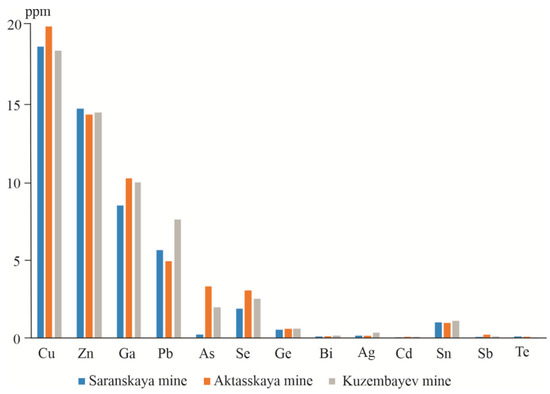
Figure 10.
Distributions of the average contents of chalcophile elements (Table 2) in the k7 seam of the Karaganda coal basin.
The analysis of the vertical distribution of sulfur (S) reveals saturation of the roof and bottom of the k7 seam with sulfur. At the T. Kuzembayev mine, the maximum concentration occurs in the contact zones, which contain minimal proportions of S.
The distributions of Te, Cu, Ga, and Se are similar to that of S across the three mines (Figure 11). Their maximum concentrations (Te 0.1 ppm, Cu 20.437 ppm, Ga 10.325 ppm, and Se 3.106 ppm) are observed at the Aktasskaya mine.
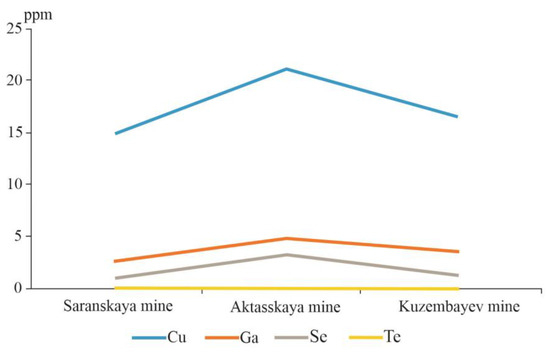
Figure 11.
Te, Cu, Ga, and Se distributions in the coal of the k7 seam.
An elevated average Cu content in coals is commonly observed in many deposits often associated with epigenetic sulfide mineralization in hard coals [28,29]. The high Cu content in CLs suggests the presence in coal of both the Cusulf form and Cu as part of the clastogenic material. Conversely, at the Aktasskaya mine, the highest Cu concentration in the roof and bottom of the formation may indicate the presence of a Cusorb form with either a diagenetic or epigenetic (infiltration) nature [25]. At the T. Kuzembaev mine, the increased Cu content occurs in the contact zones. When the sulfur content of coal increases, sulfide copper Cusulf usually dominates. The absence of a Cu–S correlation indicates the absence or small presence of Cusulf. (Figure 12) [43,44].
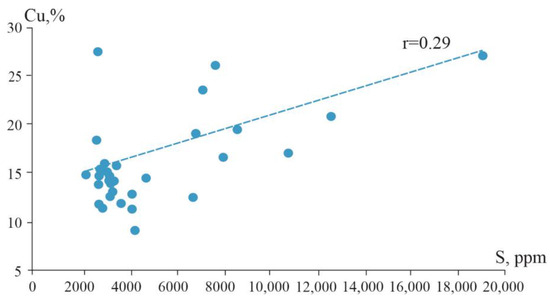
Figure 12.
Cu–S correlation in the coal of the Karaganda coal basin.
Among the siderophile elements, Sc is of industrial interest, with concentrations ranging from 5.4 to 7.0 ppm. Its content exceeds the Clarke value in coal by two times (Table 2). Despite the abundance of data on scandium content in coals, its geochemistry has been poorly understood. Over the past few decades, extensive studies of trace elements in coal deposits and basins on all continents have revealed that coals serve as concentrators of many valuable metals. Scandium is of particular interest among them as an element that lacks significant industrial deposits of its own, and is typically extracted incidentally during the development of ores of other metals. However, it often forms anomalies in coal ash, reaching industrially significant concentrations. The ashes of such coals could potentially compete with traditional sources of scandium. Despite a considerable amount of information about the scandium content in coals, its geochemistry has not been sufficiently studied [45].
Figure 13 illustrates the distributions of siderophile elements in the mines, indicating similar proportions at the Aktasskaya and Kuzembayev mines, while the Saranskaya mine exhibits minimal content of these elements.
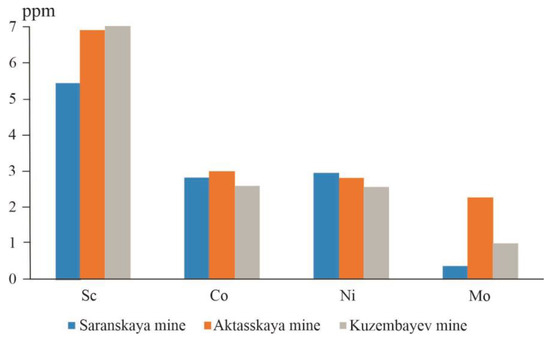
Figure 13.
Distributions of the average contents of siderophile elements (Table 2) in the k7 seam of the Karaganda coal basin.
The vertical distribution of Sc reveals its maximum concentration in the CLs. The uneven distribution and accumulation of Sc are influenced by the geological development of the coal basin and the composition of the coal accumulation basin’s feeding area [45]. The pathways through which Sc enters coals remain insufficiently studied and require further research.
Analyzing the vertical distributions of trace elements in the k7 seam (Figure 14) reveals that the highest concentrations of all trace elements are found in the upper coal–lower coal and coal–CL contact zones. Conversely, in the CL, the accumulation of trace elements is minimal.
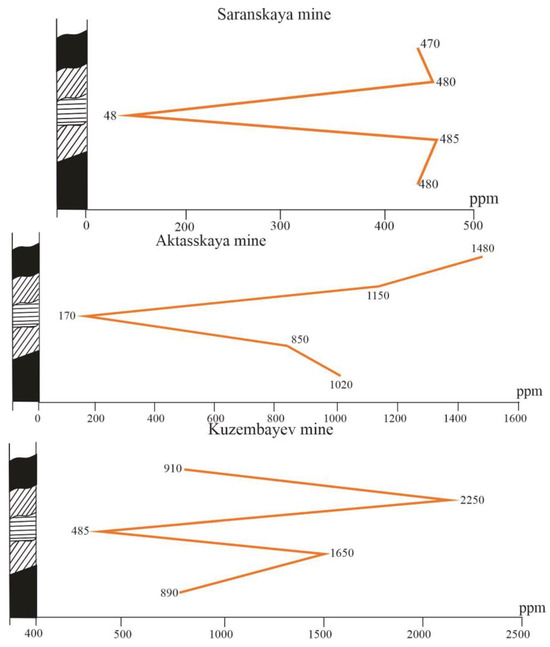
Figure 14 illustrates that at the Saranskaya mine, trace elements are equally abundant in the contact zones between coal and the CL, with slightly lower accumulations in the bottom and roof of the k7 seam; the accumulations of trace elements are slightly lower compared to the contact zones.
Conversely, at the Aktasskaya mine, the maximum accumulation of trace elements occurs in coals, especially in the roof, while the CL exhibits minimal trace element content. Similarly, at the Kuzembayev mine, the maximum concentration of trace elements is found in the contact zones between coal and the CL, particularly in the zone of contact with the roof.
Early conducted and published studies [24] have shown that the main sources of trace elements in the k7 coal seam are igneous rocks, both within in the area of the Karaganda basin and beyond. An analysis of the main oxides of coal and CLs of the k7 seam using the K2O/Na2O–SiO2 ratios was conducted to determine their tectonic conditions and origin using a two-dimensional diagram [46]. The tectonic settings in which siliciclastic rocks have not been strongly affected by post-depositional weathering and metamorphism are (i) PM (passive margin), (ii) ACM (active continental margin), and (iii) ARC (oceanic/continental). A two-dimensional graph between log (Na2O/K2O)–SiO2 (Figure 15a) shows that the samples fell within the field of the oceanic/continental arc (ARC), indicating that the source rocks for the k7 seam samples were derived from the volcanic arc, which is also confirmed by previous studies. The La/Th–Hf diagram is a widely used source identification diagram [47,48]. Some trace elements, such as Hf, La, and Th, were considered stable during sedimentation, so their concentrations and element ratios can be used to determine origin [49]. The Hf–La/Th dependence diagram is widely used to determine the source region [47,48,50]. On the Hf–La/Th discrimination graph (Figure 15b), most of the studied samples are dispersed in or near long fields of volcanic arc sources, as well as in or near areas with a mixed content of felsic/basic sources. Consequently, the source of the k7 coal seam is mainly felsic and basic material.
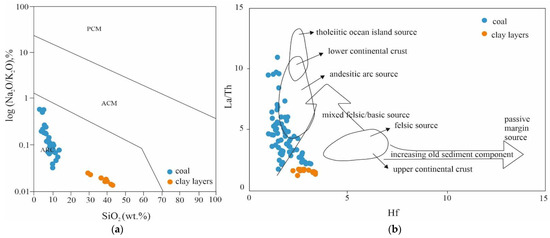
Figure 15.
Tectonic discrimination diagrams for k7 seam coal: (a) log (Na2O/K2O)–SiO2, ARC—Island arc; ACM—active continental margin; PM—passive margin; and (b) La/Th–Hf diagrams.
Although the proportions of some elements (e.g., Al and Ti) are not necessarily constant depending on the origin and sedimentary zones, they may vary depending on the size of the sediment particles [51]. However, the Al2O3/SiO2 ratio in most sedimentary rocks is similar to the source rock and serves as a reliable indicator for estimating the source rock of the coal basin [52,53]. Typical Al2O3/TiO2 ratios for basic, intermediate, and acidic igneous rocks range from 8–21 and 21–70, respectively [53]. The Al2O3/TiO2 ratios in all samples from the k7 coal seam fall within the range from 17 to 70, indicating that the initial rock of the k7 coal is intermediate and acidic, as shown in Figure 16a. However, Al and Ti can migrate during the diagenetic or epigenetic stage, and the results obtained can only be used as a reference point [51].
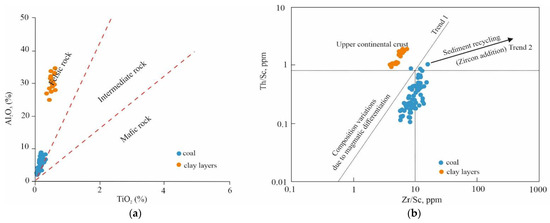
Figure 16.
Discrimination diagrams for (a) Al2O3/TiO2 and (b) Th/Sc versus Zr/Sc La/Th–Hf of the k7 seam.
The geochemistry of precipitation is always influenced by hydraulic sorting, which controls the distribution of certain trace elements [48]. Scandium (Sc) is concentrated in the main rocks, and zirconium (Zr) is concentrated in zircon. Therefore, zircon enrichment in clastic sedimentary rocks can be studied using the Zr/Sc and Th/Sc ratios [54]. The Zr/Sc ratios vary significantly depending on the Th/Sc ratio in mature or recirculating sediments, whereas Th/Sc is usually positively correlated with Zr/Sc in first-cycle sediments. These ratios depend on the nature of the source rocks [54]. In the Zr/Sc vs. Th/Sc scattering diagram (Figure 16b), two reservoir samples appear along the trend of changes in the igneous composition of the rock as a whole, indicating that there was no noticeable sedimentary sorting and recycling in the rocks.
4. Conclusions
The totality of the tectonic position, the diversity of the local geochemical background, and the multiplicity of geological conditions in the territory of the Karaganda coal basin have led to an interest in studying their metalliferous content and the main geological factors that influenced the accumulation of trace elements in coals. This study investigated the geochemical characteristics and distribution patterns of trace elements in the k7 seam of the Karaganda coal basin, revealing a significant presence of lithophile elements surpassing the Clarke value for coal. This analysis identified Nb(Ta)–Zr(Hf)–Li mineralization along with associated elements (Ba, Ga, Sr, Sc, etc.) in the k7 seam, exhibiting distinct specificity due to both compositional factors and the nature of mineralization sources. Detailed examination of trace elements with industrial interest highlighted varied accumulated sources in the studied coals. Notably, the k7 seam exhibited a high concentration of Li, predominantly confined to the CLs, suggesting a clastogenic mechanism for Li entry into coals. A positive correlation with Al2O3 and a less positive correlation with K2O indicated sorption-driven Li accumulation in CLs rich in hydromicas. Additionally, Ta, Nb, and Ba, alongside Li, accumulated in the CLs, implying a mixture of clastogenic and sorption-based accumulation mechanisms in coal. The study also found concentrations Zr and Hf, primarily in contact zones between the roof / base and the CL, suggesting the presence of terrigenous material, with the possible introduction of Zr and Hf via thermal water with elevated concentrations.
The k7 seam exhibits notable radioactivity in the CLs, while coal samples display minimal radioactivity levels. Additionally, the coals in the k7 seam show heightened concentrations of sulfur (S), with distribution patterns resembling those of tellurium (Te), copper (Cu), gallium (Ga), and selenium (Se). This suggests a potential correlation between S and the accumulation and distribution of these elements. The presence of scandium (Sc) in the k7 seam is characterized by non-uniform distribution and remains relatively understudied, and its elevated concentration holds industrial significance.
Furthermore, the k7 seam harbors valuable metal resources such as niobium (Nb), tantalum (Ta), zirconium (Zr), hafnium (Hf), vanadium (V), and gallium (Ga), among others. This abundance positions the Karaganda coal basin at an average level in terms of reserves of rare trace elements.
Based on the results of geochemical data and petrochemical diagrams, the source of trace elements in the k7 seam coals is mainly assumed to be felsic igneous rocks. Geochemical discrimination graphs indicate that the deposits of the k7 seams originated from volcanic arc conditions, as confirmed by the regional geology. Therefore, the coals of the k7 seam should be of interest for extracting the main useful components. Profitability in their processing can be achieved through selective extraction. Simultaneously, the resulting ash slags undergo complex processing to extract a group of metals.
Author Contributions
Conceptualization, methodology, validation, resources, writing, editing, and formal analysis: A.K., I.B. and A.A.; investigation, A.K., A.A., I.B. and N.A.; funding acquisition: A.K.; project administration: A.K. and A.A. All authors have read and agreed to the published version of the manuscript.
Funding
This research was funded by the Science Committee of the Ministry of Science and Higher Education of the Republic of Kazakhstan (grant No. AP13067779).
Data Availability Statement
All data from this study are available within the article.
Acknowledgments
The authors are thankful to the Science Committee of the Ministry of Science and Higher Education of the Republic of Kazakhstan for supporting and funding the research of young scientists grant no. AP13067779, thanks to which decisive analyses were carried out and the results reflected in this research were obtained. The authors are also grateful to the team of the FEGI FEB RAS for their support and high-quality analytical work.
Conflicts of Interest
The authors declare no conflict of interest.
References
- Wang, J.X.; Fu, Z.H.; Hu, Y.F.; Yang, Z.; Ma, J.L.; Sun, Y.Z. Geochemical characteristics of REY, Li, Ga trace elements in the No. 9 coal seam of the Daheng mine, Ningwu coalfield, Shanxi Province, China. China Geol. 2021, 4, 266–273. [Google Scholar] [CrossRef]
- Kalmykov, D.E.; Malikova, A.D. Zagnannyye v Ugol. Obzor Ugledobycha i Ugolnaya Energogeneratsiya v Kazakhstane. Sostoyaniye i Perspektivy. Driven into the Coal. Review of Coal Mining and Coal Energy Generation in Kazakhstan. Current State and Trends—Karaganda. 2017. Available online: https://bankwatch.org/wp-content/uploads/2018/01/KZ-Coal_RU.pdf (accessed on 1 January 2024). (In Russian).
- Arbuzov, S.I.; Vergunov, A.V.; Ilyenok, S.S.I.D. Geokhimiya, mineralogiya i genezis redkometalno-ugolnogo mestorozhdeniya v plaste XI na yuge Kuznetskogo basseyna Geochemistry, mineralogy and genesis of rare metal-coal deposits in seam XI in the south of the Kuznetsk basin. Geosph. Res. 2019, 2, 35–61. (In Russian) [Google Scholar] [CrossRef]
- Seredin, V.V. Metallonosnost’ ugley: Usloviya formirovaniya i perspektivy osvoyeniya Metal content of coals: Formation conditions and perspectives of development. Ugol’naya baza Rossii. TomVI (svodnyy, zaklyuchitel’nyy). In Osnovnyye Zakonomernosti Ugleobrazovaniya i Razmeshcheniya Uglenosnosti na Territorii Rossii; OOO “Geoinformmark”: Moscow, Russia, 2004; pp. 452–519. (In Russian) [Google Scholar]
- Seredin, V.; Finkelman, R. Metalliferous coals: A review of the main genetic and geochemical types. Int. J. Coal Geol. 2008, 76, 253–289. [Google Scholar] [CrossRef]
- Seredin, V.; Dai, S. Coal deposits as potential alternative sources for lanthanides and yttrium. Int. J. Coal Geol. 2012, 94, 67–93. [Google Scholar] [CrossRef]
- Seredin, V.; Dai, S.; Sun, Y.; Chekryzhov, I.Y. Coal deposits as promising sources of rare metals for alternative power and energy-efficient technologies. Appl. Geochem. 2013, 31, 1–11. [Google Scholar] [CrossRef]
- Dai, S.; Finkelman, R.B. Coal geology in china: An overview. Int. Geol. Rev. 2018, 60, 531–534. [Google Scholar] [CrossRef]
- Dai, S.; Chekryzhov, I.; Seredin, V.; Nechaev, V.; Graham, I.; Hower, J.; Ward, C.; Ren, D.; Wang, X. Metalliferous coal deposits in East Asia (Primorye of Russia and South China): A review of geodynamic controls and styles of mineralization. Gondwana Res. 2016, 29, 60–82. [Google Scholar] [CrossRef]
- Dai, S.; Yan, X.; Ward, C.R.; Hower, J.C.; Zhao, L.; Wang, X.; Zhao, L.; Ren, D.; Finkelman, R.B. Valuable elements in Chinese coals: A review. Int. Geol. Rev. 2016, 60, 590–620. [Google Scholar] [CrossRef]
- Wang, X.; Pan, Z.; Pan, W.; Yin, X.; Chai, P.; Yang, Q. Mineralogical and geochemical characteristics of the Permian coal from the Qinshui basin, northern China, with emphasis on lithium enrichment. Int. J. Coal Geol. 2019, 214, 103254. [Google Scholar] [CrossRef]
- Arbuzov, S.I.; Volostnov, A.V.; Mashenkin, V.S.; Mezhibor, A.M. Scandium in the coals of Northern Asia (Siberia, Russian Far East, Mongolia, Kazakhstan). Russ. Geol. Geophys. 2014, 55, 1649–1660. [Google Scholar] [CrossRef]
- Hower, J.C.; Fu, B.; Dai, S. Geochemical partitioning from pulverized coal to fly ash and bottom ash. Fuel 2020, 279, 118542. [Google Scholar] [CrossRef]
- Arbuzov, S.I.I.D. Geokhimiya i Metallonosnost Ugley Krasnoyarskogo Kraya. In Geochemistry and Metal Content of Coals of the Krasnoyarsk Region Tomskiy Politekhnicheskiy Universitet; STT: Tomsk, Russia, 2008; 300p, Available online: https://koha.lib.tsu.ru/cgi-bin/koha/opac-detail.pl?biblionumber=524080 (accessed on 14 December 2023).
- Karagandinskiy Ugolnyy Basseyn. Karaganda Coal Basin. Available online: http://www.mining-enc.ru/k/karagandinskij-ugolnyj-bassejn/ (accessed on 23 December 2023). (In Russian).
- Amangeldikyzy, A.; Kopobayeva, A.N.; Blyalova, G.G.; Askarova, N.S. Geochemical speciation of coals in the Karaganda coal Basin. Min. J. Kazakhstan 2023, 7, 15–20. [Google Scholar] [CrossRef]
- Dai, S.; Finkelman, R.B. Coal as a promising source of critical elements: Progress and future prospects. Int. J. Coal Geol. 2018, 186, 155–164. [Google Scholar] [CrossRef]
- Liu, P.; Huang, R.; Tang, Y. Comprehensive understandings of rare earth element (REE) speciation in coal fly ashes and implication for REE extractability. Environ. Sci. Technol. 2019, 53, 5369–5377. [Google Scholar] [CrossRef] [PubMed]
- Eterigho-Ikelegbe, O.; Harrar, H.; Bada, S. Rare earth elements from coal and coal discard—A review. Miner. Eng. 2021, 173, 107187. [Google Scholar] [CrossRef]
- Baba, A.; Kaya, A. Leaching characteristics of solid wastes from thermal power plants of western Turkey and comparison of toxicity methodologies. J. Environ. Manag. 2004, 73, 199–207. [Google Scholar] [CrossRef] [PubMed]
- Hower, J.C.; Groppo, J.G.; Joshi, P.; Preda, D.V.; Gamliel, D.P.; Mohler, D.T.; Wiseman, J.D.; Hopps, S.D.; Morgan, T.D.; Beers, T.; et al. Distribution of lanthanides, yttrium, and scandium in the pilot-scale beneficiation of fly ashes derived from Eastern Kentucky coals. Minerals 2020, 10, 105. [Google Scholar] [CrossRef]
- Li, X.; Ma, B.; Wang, C.; Chen, Y.; Yang, W.; Zhang, W. A sustainable process to recycle aluminum from coal fly ash for simultaneous removal of iron: Solid waste management and evaluation. Miner. Eng. 2022, 184, 107638. [Google Scholar] [CrossRef]
- Bekman, V.M.; Seydalin, O.A.; Zinova, R.A. Geologiya Karagandinskogo Ugolnogo Basseyna. Kollektiv avtorov. In Karaganda Coal Basin. Joint Authorship; Nedra: Moscow, Russia, 1972; p. 415. Available online: https://rusneb.ru/catalog/000016_000021_CHONB (accessed on 23 January 2024). (In Russian)
- Kopobayeva, A.; Amangeldikyzy, A.; Blyalova, G.; Askarova, N. Mineralogical and Geochemical Features of Coals and Clay Layers of the Karaganda Coal Basin. Minerals 2024, 14, 349. [Google Scholar] [CrossRef]
- Yudovich, Y.E.; Ketris, M.P. Tsennyye Elementy-Primesi v Uglyakh. Ekaterinburg: Izd-vo UrO RAN Valuable Trace Elements in Coals; Yekaterinburg; Pub/House UrO RAN: Shinagawa City, Tokyo, Japan, 2006; p. 538. Available online: https://www.geokniga.org/books/8321 (accessed on 12 January 2024). (In Russian)
- Liu, B.J.; Chu, G.C.; Zhao, C.L.; Sun, Y.Z. Leaching behavior of Li and Ga from granitic rocks and sorption on kaolinite: Implications for their enrichment in the Jungar Coalfield, Ordos Basin. China Geol. 2022, 5, 34–45. [Google Scholar] [CrossRef]
- Kolker, A.; Scott, C.; Lefticariu, L.; Mastalerz, M.; Drobniak, A.; Scott, A. Trace element partitioning during coal preparation: Insights from U.S. illinois basin coals. Int. J. Coal Geol. 2021, 243, 103781. [Google Scholar] [CrossRef]
- Li, J.; Wu, P.; Yang, G.; Pan, L.; Zhuang, X.; Querol, X.; Shangguan, Y. Enrichment of li-ga-zr-hf and se-mo-cr-V-as-pb assemblages in the no. 11 superhigh organic sulfur coal from the sangshuping coal mine, weibei coalfield, shaanxi, north china. Energies 2020, 13, 6660. [Google Scholar] [CrossRef]
- Ilyenok, S.S. Geokhimiya Elementov-Primesey v Uglyakh Azeyskogo Mestorozhdeniya Irkutskogo Ugolnogo Basseyna Geochemistry of Trace Elements in Coals of the Azeyskoye Deposit of the Irkutsk Coal Basin. 2017. Available online: https://earchive.tpu.ru/bitstream/11683/46973/1/dis00240.pdf (accessed on 29 December 2023). (In Russian).
- Dai, S.; Hower, J.C.; Finkelman, R.B.; Graham, I.T.; French, D.; Ward, C.R.; Zhao, L. Organic associations of non-mineral elements in coal: A review. Int. J. Coal Geol. 2020, 218, 103347. [Google Scholar] [CrossRef]
- Fu, J.; Chen, T.; Cui, F. Zonal Geochemistry and Elasticity Characteristics of Gallium- and Lithium-rich No. 6 Coalbed in the Haerwusu Mine, North China. Minerals 2024, 14, 404. [Google Scholar] [CrossRef]
- Lewińska-Preis, L.; Fabiańska, M.J.; Ćmiel, S.; Kita, A. Geochemical distribution of trace elements in Kaffioyra and Longyearbyen coals, Spitsbergen, Norway. Int. J. Coal Geol. 2009, 80, 211–223. [Google Scholar] [CrossRef]
- Liu, J.; Dai, S.; Song, H.; Nechaev, V.P.; French, D.; Spiro, B.F.; Zhao, J. Geological factors controlling variations in the mineralogical and elemental compositions of late permian coals from the zhijin-nayong coalfield, western guizhou, China. Int. J. Coal Geol. 2021, 247, 103855. [Google Scholar] [CrossRef]
- Amangeldykyzy, A. Issledovaniye Rasprostranennosti Redkozemelnykh Metallov v Uglyakhglavnykh Ugolnykh Basseynov Tsentralnogo Kazakhstana Study of the Prevalence of Rare Earth Metals in Coals MAIN Coal Basins of Central Kazakhstan. 2021. Available online: https://www.geokniga.org/bookfiles/geokniga-issledovanie-rasprostranennosti-redkozemelnyh-metallov.pdf (accessed on 21 January 2024). (In Russian).
- Zhao, L.; Dai, S.; Nechaev, V.P.; Nechaeva, E.V.; Graham, I.T.; French, D.; Sun, J. Enrichment of critical elements (Nb-Ta-Zr-Hf-REE) within coal and host rocks from the Datanhao mine, Daqingshan Coalfield, Northern China. Ore Geol. Rev. 2019, 111, 102951. [Google Scholar] [CrossRef]
- Liu, J.; Song, H.; Dai, S.; Nechaev, V.P.; Graham, I.T.; French, D.; Nechaeva, E.V. Mineralization of REE-Y-Nb-Ta-Zr-Hf in wuchiapingian coals from the Liupanshui Coalfield, Guizhou, Southwestern China: Geochemical evidence for terrigenous input. Ore Geol. Rev. 2019, 115, 103190. [Google Scholar] [CrossRef]
- Nechaev, V.P.; Bechtel, A.; Dai, S.; Chekryzhov, I.Y.; Pavlyutkin, B.I.; Vysotskiy, S.V.; Ignatiev, A.V.; Velivetskaya, T.A.; Guo, W.; Tarasenko, I.A.; et al. Bio-geochemical evolution and critical element mineralization in the Cretaceous-Cenozoic coals from the southern Far East Russia and northeastern China. Appl. Geochem. 2020, 117, 104602. [Google Scholar] [CrossRef]
- Ahmed, U.A.Q.; Wagner, N.J.; Joubert, J.A. Quantification of U, Th and specific radionuclides in coal from selected coal fired power plants in South Africa. PLoS ONE 2020, 15, e0229452. [Google Scholar] [CrossRef]
- IAEA. Extent of Environmental Contamination by Naturally Occurring Radioactive Material (NORM) and Technological Options for Mitigation; International Atomic Energy Agency: Vienna, Austria, 2003. [Google Scholar]
- United Nations Scientific Committee on the Effects of Atomic Radiation. Sources and Effects of Ionizing Radiation; United Nations: New York, NY, USA, 1993.
- Arbuzov, S.I.; Maslov, S.G.; Volostnov, A.V.; Ilyenok, S.S.; Arkhipov, V.S. Soedinenija urana i torija v ugljah i torfah Severnoj Azii. Him. Tverd. Topl. 2012, 1, 55–68. (In Russian) [Google Scholar]
- Finkleman, R.B.; Palmer, C.A.; Krasnow, M.R.; Aruscavage, P.J.; Sellers, G.A.; Dulong, F.T. Combustion and leaching behavior of elements in the Argon Premium Coal Samples. Energy Fuels 1990, 4, 766–767. [Google Scholar] [CrossRef]
- Yudovich, Y.E.; Ketris, M.P. Toksichnyye Elementy Primesi v Iskopayemykh Uglyakh. In Toxic Trace Elements in Mineral Coals; UrO RAS: Yekaterinburg, Russia, 2005; p. 648. Available online: https://www.geokniga.org/books/10695 (accessed on 15 September 2023). (In Russian)
- Guo, W.; Wang, Z.; Zhao, L.; Liu, B.; Liu, S.; Zhang, H.; Wang, J.; Zhao, C. Occurrence and origin of Cu, as and Se in a magmatic affected anthracite from the Yunjialing coal Mine, Handan Coalfield, northern China. Ore Geol. Rev. 2023, 154, 105345. [Google Scholar] [CrossRef]
- Arbuzov, S.I.; Priroda Anomalnykh Kontsentratsiy Skandiya v Uglyakh. Izvestiya Tomskogo Politekhnicheskogo Universiteta The Nature of Anomalous Concentrations of Scandium in Coals. News of Tomsk Polytechnic University, 2013, 323 №1. Available online: https://earchive.tpu.ru/bitstream/11683/4894/1/bulletin_tpu-2013-323-1-10.pdf (accessed on 9 October 2023). (In Russian).
- Roser, B.P.; Korsch, R.J. Provenance signature of sandstone mudstone determined using discriminate function analysis of major element data. Chem. Geol. 1988, 67, 119–139. [Google Scholar] [CrossRef]
- Gu, X.X.; Liu, J.M.; Zheng, M.H.; Tang, J.X.; Qi, L. Provenance and Tectonic Setting of the Proterozoic Turbidites in Hunan, South China: Geochemical Evidence. J. Sediment. Res. 2002, 72, 393–407. [Google Scholar] [CrossRef]
- Armstrong-Altrin, J.S. Evaluation of two multidimensional discrimination diagrams from beach and deep-sea sediments from the Gulf of Mexico and their application to Precambrian clastic sedimentary rocks. Int. Geol. Rev. 2015, 57, 1446–1461. [Google Scholar] [CrossRef]
- Taylor, S.R.; McLennan, S.M. The Continental Crust: Its Composition and Evolution; Blackwell: Oxford, UK, 1985; pp. 1–311. [Google Scholar]
- Floyd, P.A.; Leveridge, B.E. Tectonic environment of the Devonian Gramscatho basin, south Cornwall: Framework mode and geochemical evidence from turbiditic sandstones. J. Geol. Soc. Lond. 1987, 144, 531–542. [Google Scholar] [CrossRef]
- Spears, D.A.; Arbuzov, S.I. A geochemical and mineralogical update on two major tonsteins in the UK Carboniferous Coal Measures. Int. J. Coal Geol. 2019, 210, 103192. [Google Scholar] [CrossRef]
- Dai, S.; Hower, J.C.; Ward, C.R.; Guo, W.; Song, H.; O‘Keefe, J.M.K.; Xie, P.; Hood, M.M.; Yan, X. Elements and phosphorus minerals in the middle Jurassic inertiniterich coals of the Muli Coalfield on the Tibetan Plateau. Int. J. Coal Geol. 2015, 144, 23–47. [Google Scholar] [CrossRef]
- Hayashi, K.-I.; Fujisawa, H.; Holland, H.D.; Ohmoto, H. Geochemistry of ~1.9 Ga sedimentary rocks from northeastern Labrador, Canada. Geochim. Cosmochim. Acta 1997, 61, 4115–4137. [Google Scholar] [CrossRef]
- McLennan, S.M. Weathering and global denudation. J. Geol. 1993, 101, 295–303. [Google Scholar] [CrossRef]
Disclaimer/Publisher’s Note: The statements, opinions and data contained in all publications are solely those of the individual author(s) and contributor(s) and not of MDPI and/or the editor(s). MDPI and/or the editor(s) disclaim responsibility for any injury to people or property resulting from any ideas, methods, instructions or products referred to in the content. |
© 2024 by the authors. Licensee MDPI, Basel, Switzerland. This article is an open access article distributed under the terms and conditions of the Creative Commons Attribution (CC BY) license (https://creativecommons.org/licenses/by/4.0/).